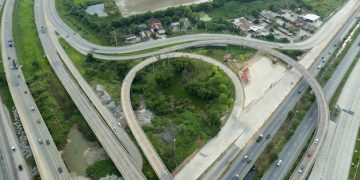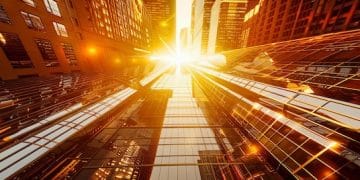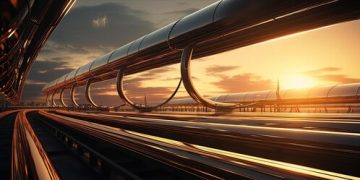Government Spending on Infrastructure: Multiplier Effect on US Economy
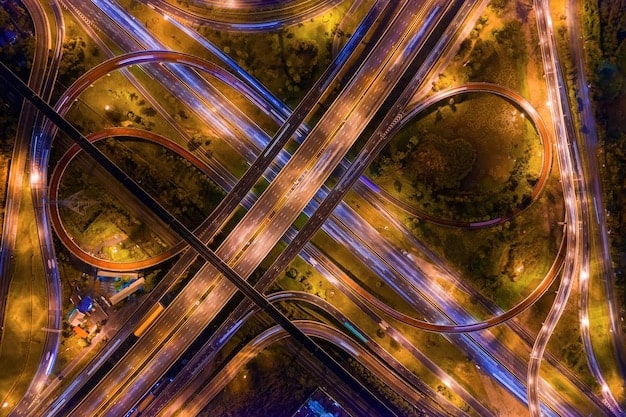
Government spending on infrastructure projects in the US can trigger a multiplier effect, stimulating economic growth by creating jobs, increasing productivity, and enhancing overall economic activity beyond the initial investment.
The impact of **government spending on infrastructure projects: a look at the multiplier effect on the US economy** is a crucial aspect of economic policy. Strategic investments in infrastructure can create substantial economic benefits.
Understanding the Basics of Government Infrastructure Spending
Government infrastructure spending refers to public funds allocated for the development, maintenance, and improvement of a nation’s essential facilities and systems. This encompasses a wide range of projects.
Infrastructure investments are not merely about construction; they are about fostering long-term economic prosperity and enhancing the quality of life for citizens.
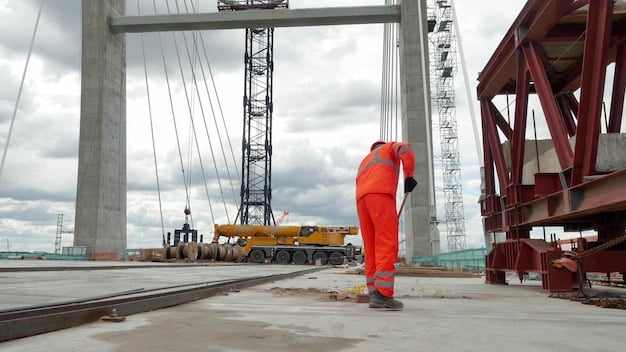
Types of Infrastructure Projects
Infrastructure projects come in various forms, each serving a unique purpose. Understanding these types is essential to grasp the breadth of government spending.
- Transportation Infrastructure: Roads, bridges, highways, airports, and public transit systems that facilitate the movement of people and goods.
- Utilities Infrastructure: Water and sewer systems, power grids, and telecommunications networks that provide essential services to communities.
- Social Infrastructure: Schools, hospitals, and public housing that support public welfare and community development.
The Role of Government in Infrastructure Development
Governments play a vital role in infrastructure development. This role includes planning, funding, and overseeing projects to ensure they meet public needs and safety standards.
Public investment can address market failures, stimulate economic activity, and provide essential services that the private sector may not find profitable enough to undertake.
The multiplier effect is a key concept in understanding the broader impact of government spending. It refers to the ripple effect that occurs when an initial injection of spending into the economy leads to a more significant increase in overall economic activity.
The Multiplier Effect Explained
The multiplier effect is a core economic principle that explains how an initial increase in government spending can generate a proportionally larger increase in overall economic output. This concept is particularly relevant to infrastructure projects.
Understanding how the multiplier effect works is crucial for appreciating the full impact of government investment.
How the Multiplier Effect Works
The multiplier effect operates through a chain reaction of spending and income generation. When the government invests in infrastructure projects, it directly creates jobs.
These newly employed workers then spend their wages on goods and services, increasing demand in other sectors of the economy.
- Initial Government Spending: The government invests in a new highway project.
- Job Creation: Construction workers are hired for the project, receiving wages.
- Increased Consumer Spending: Workers spend their wages on groceries, housing, and other goods and services.
- Business Revenue Growth: Businesses experience increased sales, leading to higher profits and potential expansion.
Factors Influencing the Multiplier Effect
Several factors can influence the size of the multiplier effect. These factors determine how effectively government spending translates into broader economic growth.
Higher marginal propensity to consume, lower tax rates, and increased business investment can amplify the multiplier effect.
The multiplier effect is often used to justify government intervention in the economy, particularly during recessions or periods of slow growth. Infrastructure projects are thus a means for stimulus.
Historical Impact of Infrastructure Spending in the US
Throughout US history, government spending on infrastructure projects has played a significant role in driving economic growth and development. These projects have shaped the nation’s landscape.
Examining historical examples provides valuable insights into the potential impact of current and future infrastructure investments.
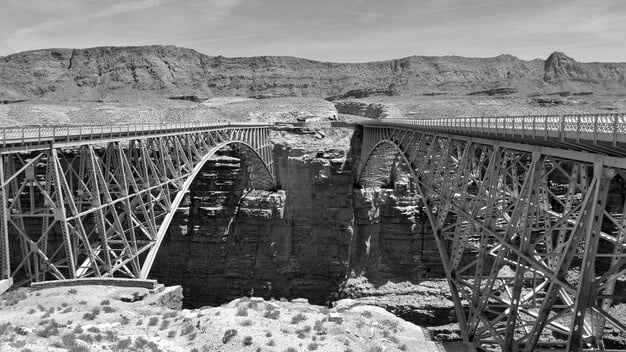
The New Deal Era
During the Great Depression, President Franklin D. Roosevelt’s New Deal programs included extensive investments in public works projects. These projects aimed to create jobs and stimulate economic activity.
The Civilian Conservation Corps (CCC) and the Public Works Administration (PWA) were instrumental in building roads, bridges, dams, and other essential infrastructure.
- Job Creation: Employed millions of Americans, providing them with income and reducing unemployment.
- Infrastructure Development: Built essential infrastructure that supported economic growth for decades.
- Economic Stimulus: Injected much-needed capital into the economy, helping to alleviate the depression.
The Interstate Highway System
In the 1950s, President Dwight D. Eisenhower launched the Interstate Highway System, one of the most ambitious infrastructure projects in US history.
This project transformed transportation, facilitating commerce and connecting communities across the country.
The interstate highway system created jobs, improved transportation efficiency, and spurred economic development in regions previously isolated.
Current Infrastructure Challenges and Needs
Despite historical investments, the US faces significant infrastructure challenges today. Many existing facilities are aging and in need of repair or replacement.
Addressing these challenges is essential for maintaining economic competitiveness and ensuring public safety.
Aging Infrastructure
Much of the US’s infrastructure is decades old and nearing the end of its useful life. This aging infrastructure poses safety risks and inefficiencies.
Deferred maintenance has exacerbated the problem, leading to deteriorating roads, bridges, and water systems.
- Deteriorating Roads and Bridges: Resulting in traffic congestion, accidents, and increased transportation costs.
- Water System Leaks: Leading to water waste and potential contamination.
- Power Grid Vulnerabilities: Increasing the risk of blackouts and disruptions.
Investment Gaps
The current level of investment in infrastructure is insufficient to address the nation’s needs. Closing this investment gap requires a sustained commitment from both the public and private sectors.
Increased investment can modernize infrastructure, improve efficiency, and support long-term economic growth.
Addressing current challenges requires innovative solutions and strategic planning. The consequences of ignoring these challenges can be dire for economic growth.
Future Opportunities and Policy Recommendations
Looking ahead, there are significant opportunities to leverage infrastructure investments for economic growth. Strategic policies and innovative approaches are essential. Prioritizing infrastructure is essential for the future.
Adopting innovative technologies, encouraging public-private partnerships, and prioritizing sustainable development can unlock the full potential of infrastructure investments.
Leveraging Technology
Technological advancements offer new ways to improve infrastructure efficiency and sustainability. Smart technologies can optimize traffic flow.
Innovations like smart grids, intelligent transportation systems, and advanced construction materials can enhance the performance and longevity of infrastructure.
- Smart Grids: Improving energy efficiency and reliability.
- Intelligent Transportation Systems: Reducing traffic congestion and improving safety.
- Advanced Construction Materials: Enhancing the durability and sustainability of infrastructure.
Policy Recommendations
To maximize the economic impact of infrastructure investments, policymakers should adopt a comprehensive approach. This should include long-term vision and planning.
Encouraging public-private partnerships, streamlining regulations, and prioritizing sustainable development are key steps.
Targeted investments, coupled with enabling policies, can drive economic growth, create jobs, and enhance the quality of life in the US.
| Key Point | Brief Description |
|---|---|
| 🏗️ Infrastructure Spending | Government investment in essential facilities, such as roads and utilities. |
| 📈 Multiplier Effect | Increased economic activity resulting from initial government spending. |
| ⚙️ Aging Infrastructure | Deteriorating roads and bridges requiring urgent repair and modernization. |
| 💡 Policy Recommendations | Encouraging PPPs, streamlining regulations and prioritizing sustainable development. |
Frequently Asked Questions
The multiplier effect refers to the increase in economic activity that results from an initial injection of government spending. This leads to more jobs, higher incomes, and increased demand.
Infrastructure spending is vital because it creates jobs, improves productivity, and enhances the quality of life. It also ensures the smooth functioning of the economy.
The primary challenges include aging infrastructure, insufficient investment, and the need for modernization to meet current and future demands. Deferred maintenance is also a challenge.
Technology can enhance infrastructure through smart grids, intelligent transportation systems, and advanced construction materials, increasing efficiency and sustainability.
Key policies include encouraging public-private partnerships, streamlining regulations, prioritizing sustainable development, and adopting a comprehensive, long-term planning approach.
Conclusion
In conclusion, **government spending on infrastructure projects: a look at the multiplier effect on the US economy** highlights the far-reaching benefits of such investments. By creating jobs, stimulating economic activity, and enhancing overall productivity, strategic infrastructure projects are essential for long-term economic growth and prosperity in the United States.

